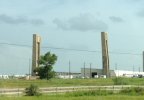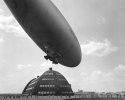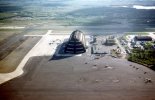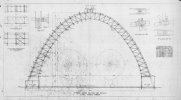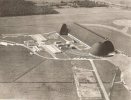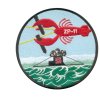The AOA of the Navy Blimp in WWII was vast.
The Atlantic/Europe theater alone had operations on four continents.

When the war ended in September 1945, there were at least 15 blimp squadrons in existence, patrolling about three million square miles of water. These LTA squadrons, whose equipment was mainly the K-type airship, performed 35,000 operational flights in the Atlantic and 20,300 flights in the Pacific. These statistics are impressive enough, but it’s their contribution to the war effort that underscores their overall importance.
The airships accumulated more than 5.5 million hours in the air, escorting nearly 90,000 ships loaded with cargo, troops, weapons, and supplies to far-flung battlefronts. It was their proud boast that no ship was ever lost under their protection.
WWII Atlantic/Europe Theater blimp bases, hangars or mooring masts.
(Not a complete list)
Amapa Field
Apalachicola Army Airfield
Atkinson Field
Aérodrome de Cuers-Pierrefeu
Bar Harbor Naval Auxiliary Air Facility (NAAF)
Barranquilla Airport
Bizerte Airfield
Cagliari Elmas Airport
Camp Cooke
Cannes – Mandelieu Airport
Caravelas Airport
Cayuga
Cocorote Airport (1935-1952)
Eglin Field
Elizabeth Field
Ensenada Airport
Fernando de Noronha Airport
Goodyear Training Field
Ibura Airport
Isla de Pinos
Kindley Field
La Chorrera Army Airfield
La Senia Airport
Lajes Field
Lido Beach Airfield
Littorio Airport
Mandinga
Marechal Cunha Machado International Airport
Moffett Federal Airfield
NAS Brunswick
NAS North Sydney
NAS Patuxent River
NAS Rockaway
Naval Air Auxiliary Station Eureka
Naval Air Auxiliary Station Watsonville
Naval Air Facility Maceio
Naval Air Facility San Julian
Naval Air Station Banana River
Naval Air Station Cape May
Naval Air Station Elizabeth City
Naval Air Station Glynco
Naval Air Station Hitchcock
Naval Air Station Houma
Naval Air Station Key West
Naval Air Station Lakehurst
Naval Air Station Port Lyautey
Naval Air Station Richmond
Naval Air Station San Juan
Naval Air Station Santa Ana
Naval Air Station South Weymouth
Naval Air Station Tillamook
Naval Air Station Tongue Point
Naval Air Station Trinidad (Hangar built by African American 80th Seabees)
Naval Air Station Weeksville
Naval Auxiliary Air Facility, Del Mar
Naval Auxiliary Air Station Shelton
Naval Auxiliary Air Station, North Bend
Naval Base Coco Solo
Naval Mine Warfare Test Station
Naval Station Argentia
Naval Station Guantanamo Bay
Naval Support Activity Charleston
Naval Surface Warfare Center Dahlgren Division
Pisa International Airport
Quillayute Naval Auxiliary Air Station
RAF Gibralta
RAF Station Ta Kali
Roosevelt Roads Naval Station
San Benito Airport
Santa Cruz Air Force Base
Santa Fe Airport
Santo Amaro do Ipitanga Airport
Vernam Field
Zandery Airport










